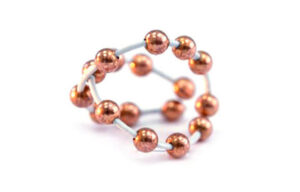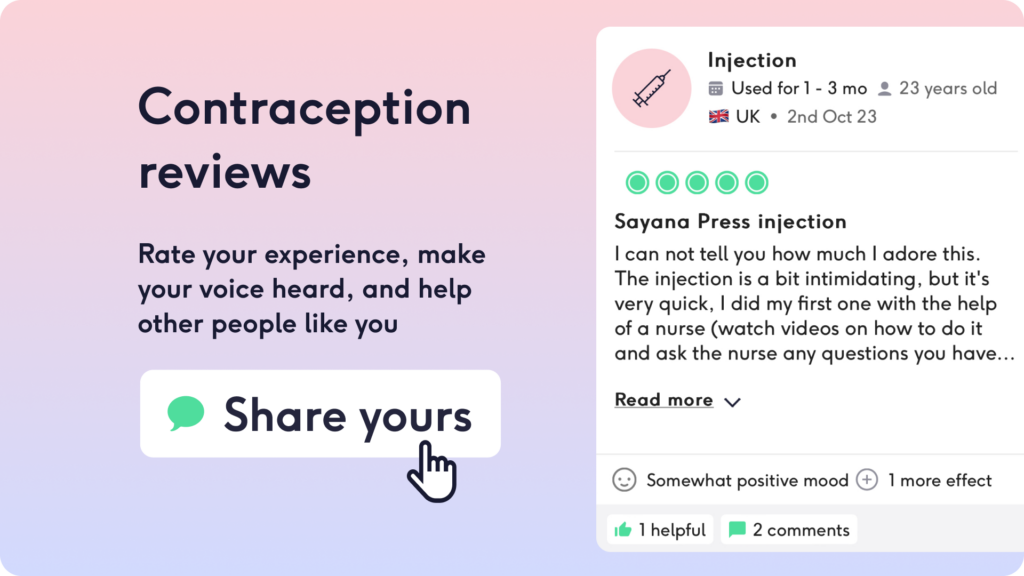Everything you need to know about the IUB Ballerine
The IUB Ballerine (intra-uterine ball) is the flashy new form of contraception that has recently found itself the hot topic on the lips of everyone we know – and it seems that people just can’t stop talking about the little spherical bundle of joy.
We’ve had so many questions on this exciting new product that we wanted to take the time to answer all of your burning questions, so here’s everything you need to know about the IUB Ballerine, and more!
What is the IUB Ballerine?

The Ballerine IUB is a hormone-free IUB that’s inserted into your uterus. It has a unique design consisting of 17 copper pearls which form a spherical shape – and it’s half the size of the traditional intrauterine devices (15mm in diameter) (you know what they say about the best things coming in the smallest packages).
The frame is coated with polyethylene terephthalate and because of the material used, it is meant to find its ideal position and fit cosily in your uterus to minimize risk of damage and irritation.
How does the IUB contraceptive coil work?
According to Ocon Medical, the IUB works by releasing small amounts of copper to provide birth control for up to 5 years. Ongoing surveillance by the manufacturer suggests the IUB is over 99% clinically effective, similar to copper IUDs, which means less than 1 in 100 women will fall pregnant over 1 year of use.
The IUB works in a similar way to standard copper IUDs, which achieve their contraceptive effect by interfering with sperm motility and egg fertilization. Tragic, these millennial sperms can’t even handle 15mm of metal.
How is the IUB Ballerine inserted?
Before you can get IUB fitted, you must attend a consultation with your healthcare provider in which they must examine you to find the position of your uterus – this involves a pelvic examination by a doctor or nurse.
Once that’s out the way, the IUB can be inserted through a small tube, which is then removed. Two removal threads made of Polypropylene which allow the healthcare provider to remove the IUB are attached to the end of the frame and extend into your vagina. These will be trimmed by your healthcare provider for maximum comfort.
The IUB stays inside your uterus and protects against pregnancy immediately after insertion. It releases small amounts of copper to provide continuous contraception for up to 5 years.
The IUB can be inserted at any time during your menstrual cycle if it is certain you are not pregnant. The makers of the IUB recommend that the best time to get your IUB inserted is the last 2 days of your menstruation when the cervix is naturally more open, and chance of pregnancy is low.
Some things that might be good to know when considering this as an option is that if your cervix is especially tight, the insertion of the IUB may be painful. If you’re really not good with pain, no need to worry as local anaesthetic or other prevention pain-reducing treatments should be available during placement.
Side effects immediately or a few minutes after insertion may be: cramping, menstrual type bleeding, feeling faint, nausea and dizziness but these should subside quickly.

How is the IUB Ballerine removed?
The IUB should only be removed by a trained healthcare professional at a GP surgery or healthcare clinic and is done by gently pulling two strings with a medical instrument. The removal process will involve a pelvic examination with a speculum.
Ballerine IUB vs IUD (copper coil)
The manufacturers of the IUB had previously suggested a small reduction in cramps and period pain for those using the IUB compared to the IUD but the study has been removed from their website so there is currently no published data on this.
On the basis of post-marketing surveillance data, the manufacturer suggests that the IUB appears to have a favourable safety profile and similar effectiveness to other currently available copper IUDs. However data from robust, independent studies comparing the IUB ballerine and copper IUDs is lacking.
Pros and Cons of the Ballerine IUB
Pros
- This is a non-hormonal coil therefore it does not affect the ovulation or the hormonal changes that occur naturally during menstrual cycle
- The IUB is unlikely to cause the side effects which can be associated with hormonal contraception such as mood swings, changes to libido and possible weight gain
- It is a highly effective method of contraception
- It lasts for up to 5 years
- It is easily reversible and an alternative to permanent sterilisation
- Fertility is restored immediately after removal
Cons
- Heavier, longer periods and spotting between periods can occur – normally for up to 2-3 months
- Sometimes difficult removals can occur
- Does not protect against HIV or STI’s, you will need to use a barrier method such as condoms for this
Risks
- There’s a small chance of you getting an infection during the first 20 days after an IUD is put in – you may be advised to have a check for sexually transmitted infections before an IUD is fitted or at the time it’s fitted
- There is a very small risk the IUB can go through (perforate) the wall of the uterus meaning you are no longer protected from pregnancy – this risk is higher if you are breastfeeding or have just given birth. In this case the IUB will need to be removed and rarely surgery may be needed
- Expulsion: the IUB may partially or completely fall out of the uterus – this isn’t common, it’s more likely to happen soon after the IUD has been put in and you may not know it has happened. Your doctor or nurse will teach you how to check the threads so you know the IUD is in place.
Why Should I use the IUB?
You might choose the Ballerine IUB if you’re looking for contraception that:
- is very effective
- is easy to use
- stops working when you stop using it
- avoids using synthetic hormones for contraception
Why shouldn’t I use the IUB?
The makers of the sub advise you should not use the IUB if you:
- might be pregnant
- have an abnormally shaped uterus – this is rare, your nurse or doctor will examine you to check the shape and position of your uterus before the IUB is inserted
- have a pelvic infection called pelvic inflammatory disease (PID) or have current behaviour that puts you at high risk of PID (for example, because you or your partner are having sexual intercourse with multiple partners)
- have had an infection in your uterus after a pregnancy or abortion in the past 3 months
- have cancer of the uterus or cervix
- have unexplained bleeding from your vagina
- have an infection in your cervix
- have Wilson’s disease (a disorder in how the body handles copper)
- are allergic to any of the IUB™’s materials (copper, nickel, titanium, PET, polypropylene)
- already have an intrauterine contraceptive in your uterus.
Where can I get the IUB
The Ballerine IUB is not available in the UK yet – it was meant to be rolled out out in 2020, but Covid-19 has grounded everything to a halt and we are unsure of when this IUB will be accessible to us all. Sorry guys!
Follow us on Instagram @Get.the.lowdown to stay updated on when it’s available.
The makers of the IUB were working hard on spreading the word and training the medical community with the goal of it soon being an option as a form of contraception in every GP surgery across the country.
For our friends across the pond, there have been some developments about the US market recently and it looks like it’ll be available there in the next four years.
It is currently available in Ireland, Austria, Switzerland, Germany, France, Spain, Belgium, Italy, Poland, Sweden, Norway, Netherlands, Hungary, Slovakia, Czech Republic, Israel, Kenya, Uganda and South Africa.
Now that you all know the ins and the outs (sorry we couldn’t resist) of the Ballerine IUB you might be thinking this is the perfect option for you, but there are plenty more options around including the hormonal coil.
When it comes to choosing contraception, it’s about finding the perfect one for you. Check out our Contraception Recommender to discover which method might suit you best.

Our medical review process
This article has been medically reviewed for factual and up to date information by a Lowdown doctor.


